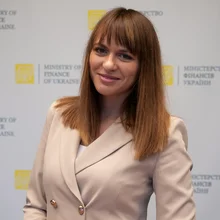
Sovereign risk manager of the year: Ukraine’s Ministry of Finance
Risk Awards 2023: War bonds programme and debt payment freeze raise $11.6 billion to fund defence against Russia

On February 24, a Russian rocket landed just 500 metres from Ukraine’s Ministry of Finance in Kyiv. With Russian troops bearing down on the country’s capital, Yuriy Butsa, government commissioner for public debt management, called an emergency meeting.
Butsa, and all five members of his team, agreed to move out of the city and continue working remotely, as they had done during the pandemic. As no-one knew which cities Russia would target, no two team members could move to the same place.
“Some contingency plans had been put in place before the war, but to execute those plans in practice is obviously a completely different conversation,” says Butsa. “Previously, we were just dealing with hypothetical situations. It’s very different to be living them.”
It’s pretty much the fastest agreement ever made between a sovereign and creditors
Yuriy Butsa, Ukraine’s Ministry of Finance
“Nobody could have predicted that this is what would have happened to us this year – working remotely from bunkers, basements and bomb shelters,” adds Alla Danylchuk, head of investor relations at the ministry.
Just four days after the invasion, Butsa’s team hosted a global investor call to provide updates on Ukraine’s financial situation and the ministry’s ongoing plan to repay its debts. More than 500 people joined the call, which was hosted from bunkers across the country. It remains the most-attended investor call in the ministry’s history.
“For that particular call there were some rocket explosions in Kyiv, which meant we lost the internet connection during a Q&A session with some of our investors,” says Danylchuk. “That was quite a memorable time.”
The ministry’s rapid adjustment to these unprecedented events, though impressive, has not been its most remarkable achievement. The war bond programme it launched in March has raised $7 billion, and in August it reached an agreement with creditors to freeze debt repayments on Ukraine’s maturing Eurobonds – a programme that should save the country around $6 billion over the next two years until August 2024, thereby averting a liquidity crisis.
These measures, along with concessional funding from allied countries and multilateral organisations, have enabled Ukraine to stabilise its finances. Now, thoughts are turning towards rebuilding the country once the war eventually ceases. To this end, the ministry is working on a legal mechanism to channel frozen Russian currency reserves into reconstruction efforts. It is also examining ways to issue new instruments to investors, with creative credit mitigation options.
Emergency funds
Ukraine’s public finances had been in relatively good shape at the turn of the year. The deficit was low and the debt-to-GDP ratio was 43%.
Nevertheless, the ministry was preparing for 2022 to be a challenging year, given the sustained impact of the pandemic on the global economy. It had bought back short-dated debt in December 2021 and January 2022, when market prices were turbulent, and was looking to roll back the country’s debt further.
The deficit was to be funded solely through domestic market funding and concessional financing that was already in place. This included $2.2 billion from the International Monetary Fund (IMF), provided as part of a programme to help foster global growth in the aftermath of Covid.
“Obviously, the war changed everything,” says Butsa.
Instead of requiring $6.5 billion to cover a projected deficit amounting to 3.5% of GDP, the ministry found itself needing $5 billion a month to cover a shortfall that would grow to an estimated 34% of GDP by December 2022. At the time of writing, the country’s debt to GDP ratio is estimated at 87%.
First aid
With the ministry’s personnel now relocated to places of relative safety, pre-agreed concessional funding saw Ukraine through the beginning of the war. The first $1.4 billion tranche of the IMF’s support was dispersed in early March, and additional funding was provided by other countries and institutions. Among the latter was the World Bank, which on March 7, approved a budget support package totalling $723 million – including a $350 million loan and $134 million in grants.
Since February 24, Ukraine has received $30 billion in financial aid, on top of the amounts agreed to the country in 2021. $12 billion of this additional funding has come in the form of grants.
On March 1, just five days after Russian troops set foot on Ukrainian soil, the ministry began issuing war bonds – in both dollars and the Ukrainian hryvnia – through auctions in which domestic and international investors can participate. To date, 170 of these auctions have taken place through Bloomberg’s auction system, which the ministry has been using to sell bonds since September 2019.
Katharine Furber, global head of emerging markets trading at Bloomberg, says: “The working relationship we’ve developed with Ukraine’s Ministry of Finance is excellent and the client feedback on the use and capabilities of our auction platform has been hugely positive.”

By October 3, the Ukrainian government had also created an app to enable domestic and international investors to buy war bonds on their phones – which sees more than 18.5 million users today.
To encourage support, the bonds are named after Ukrainian cities currently occupied by Russian troops – such as Mariupol, where Ukrainian officials believe 25,000 civilians have been killed so far, while 95% of the city has been destroyed.
The bonds have attracted more than 150,000 complete newcomers to the investment market – including Ukrainian businesses and banks, and citizens keen to support their country. Today, $265 million of these war bonds are owned by Ukrainian citizens.
The central bank, the National Bank of Ukraine (NBU), has so far prevented the buyers of war bonds from converting their maturing coupon and redemption payments from hryvnia into other currencies for fear of a foreign exchange liquidity leakage – a restriction that has limited international investment in the programme to some extent.
The NBU has agreed to lift such restrictions from April 1, 2023, allowing international investors able to convert their coupon and redemption payments into foreign currency.
“We’ve worked a lot with the National Bank of Ukraine on this and hope this measure will provide further incentive for investors to buy our bonds,” says Danylchuk.
Maintaining investor relations
Maintaining strong relationships with investors has been a priority for the ministry, which has hosted regular investor calls throughout the war. It has also continued to produce monthly investor reports – which in March were rebranded as “wartime” reports, complete with updates on the military situation.
“Our relationship with investors is incredibly important to us, so we’ve done all we can to remain accessible to them,” says Danylchuk. “We didn’t want to lose all of the trust we’d built up with investors over the years because of this war.”

Managing the country’s debt curve remains a priority for the ministry. With a projected debt-to-GDP ratio of 87%, the ministry’s prioritisation of concessional grant financing – alongside low interest loans with tenors of 15-20 years – has enabled it to keep the debt level as low as possible under the circumstances. Indeed, Ukraine’s state debt has not grown substantially in absolute terms – standing at $84 billion by the end of January and at $88.5 billion by the end of September.
The ministry has kept up-to-date on its debt payments – including a $300 million coupon on March 1 for $20 billion of Eurobonds that were set to mature in September 2022. With the ministry initially expecting that the war would only last three months, this was a payment it was happy to make. However, by mid-July it had paid out over $1 billion in redemptions and interest to external creditors, with no end to the conflict in sight.
As it became clear that the ministry did not have enough monthly liquidity to continue paying Ukraine’s debts, Butsa realised an agreement with creditors was urgently needed to avoid a default. Officials worked closely with creditors over three weeks, and a two-year debt repayment freeze on Ukraine’s maturing Eurobonds was eventually agreed on August 10.
“It’s pretty much the fastest agreement ever made between a sovereign and creditors,” says Butsa. “The reason that negotiation went really well is because of the level of communication we have continued with investors throughout the war and the amount of investor feedback we took on board before proposing it.”
Borys Matiash, director of debt capital markets CEEMEA at BNP Paribas, says the goodwill Ukraine has built up over the past few years through investor co-operation was crucial to getting this agreement passed: “This has helped them mobilise financial resources in a quick and efficient manner, gathering support from the investor community to create an additional fiscal space at the time when it is needed the most, [and thereby] ensuring that the country continues to function and rebuild towards a prosperous future for the people of Ukraine.”.
Looking to the future
With Ukraine’s economic situation having stabilised somewhat, the ministry is turning its attention to financing the projected $38 billion deficit in the redrafted budget for 2023. It is forecasting funding requirements of $3 billion to $3.5 billion a month, compared with the $5 billion a month that has been needed this year. Most of this will be covered by the $30 billion in financial aid that has been given to Ukraine since February 24.
As more territories are liberated from Russian occupation, helping Ukraine to rebuild is another goal for the ministry. In September, an assessment conducted by the Ukrainian government, the European Commission and the World Bank found that Ukraine would need $349 billion for reconstruction – including $17 billion for “rapid recovery” projects, such as rebuilding roads, bridges, schools, medical facilities and homes. The longer the war continues, the greater these costs will become.
For the ministry, a key means of funding this reconstruction will be through accessing the more than $300 billion in Russian-owned foreign currency reserves held in central banks that Ukraine’s western allies have had frozen since the start of the conflict.
“From a moral standpoint, those who caused all the damage should have to pay for it,” says Butsa. “When Ukrainian regions are liberated, there is literally nothing left. If Russia doesn’t pay voluntarily then there should be some legal mechanism to force them to pay for what they’ve damaged.” The ministry is hopeful these reserves will be made available soon.
It is also working on a parallel solution that would involve issuing new instruments to entice investors – particularly those from the private sector – to help finance Ukraine’s reconstruction.

Nevertheless, the country’s declining credit rating still poses problems. Although Fitch Ratings gave Ukraine a B rating on February 8, by August 19 this had declined to CC. Similarly, while S&P assessed the country as B- on February 28, by August 22 the agency had lowered its rating to CCC+.
“It’s a challenge to assess our rating given our debt payment freeze agreement, as no sovereign has ever really made such an agreement before,” says Danylchuk. “Rating agencies have very strict methodologies, so when sovereigns are creative they don’t always appreciate it. We’ve tried explaining that this agreement is market-friendly and has been agreed by all parties, but they have their methodology and they won’t budge from it.”
In an attempt to resolve the issue, the ministry is working with investors to devise credit risk mitigation options, including partial guarantees, full guarantees and brady bonds.
“There’s no defined solution at this stage,” says Butsa. “But we’re looking at all the options that have been used within the market in the past to find the best solution and encourage more investors to help us rebuild the country.”
A financial working group composed of the World Bank, IMF and countries such as the US will meet each month throughout 2023 to assess how much additional financial aid Ukraine needs. The group is also providing legal assistance to Ukraine’s Ministry of Justice to facilitate the country’s efforts to access Russia’s frozen reserves.
Canada has pledged additional funding through its $500 million Ukraine sovereignty bond, which is the product of a months-long collaboration between the countries’ finance ministries and other Canadian authorities. Launched in November, the proceeds will be given to Ukraine’s Ministry of Finance.
“We haven’t discussed an instrument like this with any other country yet, but we are open to those discussions,” says Butsa. “We’ll have to see how Canada’s goes and what we can do to build on it.”
At this point in Risk.net’s interview, Butsa pauses to listen to an announcement that has just been made over the intercom at the ministry’s offices. Two days previously, Russian missiles hit key electricity infrastructure in Kyiv – causing a blackout across the country and killing at least six people.
“Sometimes these announcements are air raid sirens, so I wanted to make sure that what we just heard wasn’t one of those,” he says. “We still don’t have lights outside. I’m looking out of my window now and it’s a full blackout outside, so we’re very lucky to have electricity and lights here in the ministry offices.
“There are a lot of countries who suffer the same conditions we face right now on a daily basis, without ever facing a war, so you just have to adapt and stay strong – which not only applies to our team here at the ministry, but to our country as well.”
Only users who have a paid subscription or are part of a corporate subscription are able to print or copy content.
To access these options, along with all other subscription benefits, please contact info@risk.net or view our subscription options here: http://subscriptions.risk.net/subscribe
You are currently unable to print this content. Please contact info@risk.net to find out more.
You are currently unable to copy this content. Please contact info@risk.net to find out more.
Copyright Infopro Digital Limited. All rights reserved.
As outlined in our terms and conditions, https://www.infopro-digital.com/terms-and-conditions/subscriptions/ (point 2.4), printing is limited to a single copy.
If you would like to purchase additional rights please email info@risk.net
Copyright Infopro Digital Limited. All rights reserved.
You may share this content using our article tools. As outlined in our terms and conditions, https://www.infopro-digital.com/terms-and-conditions/subscriptions/ (clause 2.4), an Authorised User may only make one copy of the materials for their own personal use. You must also comply with the restrictions in clause 2.5.
If you would like to purchase additional rights please email info@risk.net
More on Awards
Collateral management and optimisation product of the year: CloudMargin
Delivering the modern blueprint for enterprise collateral resilience
Flow market-maker of the year: Citadel Securities
Risk Awards 2026: No financing; no long-dated swaps? “No distractions,” says Esposito
Pricing and analytics: fixed income – Quantifi
Quantifi delivers high-performance, transparent and adaptable pricing and risk analytics for fixed income and credit markets
Derivatives house of the year: Citi
Risk Awards 2026: Rev up, RWAs down, as US bank gets back on track (with added XiNG and XiP)
Technology vendor of the year: SS&C Algorithmics
Risk Awards 2026: From cloud, to chips, to maths tricks – vendor getting more out of existing tech
SS&C Algorithmics: winner’s interview with Curt Burmeister
SS&C Algorithmics wins three categories in this year’s Markets Technology Awards in addition to Technology vendor of the year at the Risk Awards
Best vendor for system support and implementation: Murex
Murex wins Best vendor for system support and implementation at the Markets Technology Awards 2026
Pricing and analytics: cross-asset and structured – Murex
Murex wins Pricing and analytics: cross-asset and structured at the Markets Technology Awards 2026 thanks to its MX.3 platform








